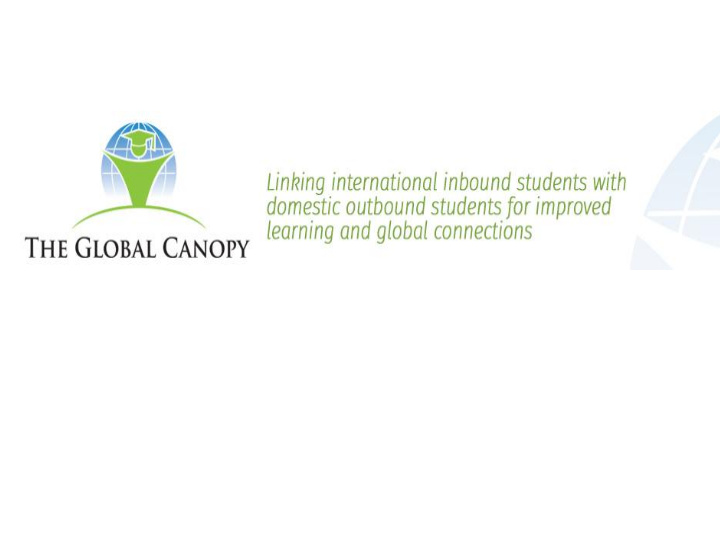



•
Project Team • Tricia McLaughlin (RMIT-project lead) • Andrea Chester (RMIT) • James Baglin (RMIT) • Phil Poronnik & Tina Hinton (Uni Syd) • Peter Davis (UoN) • Swapan Saha (UWS) • Anthony Mills (Deakin) • Roger Hadgraft (CQU)
• The partnering of the six universities represented in this project is deliberate . • Each partner represents an institution with diverse student mobility programmes and significant international student numbers. • The project team represents senior learning and teaching academics, capable of directing change and impact at their own institution and concerned about the growing chasm between inbound and outbound students in their programmes. • The team represents diverse disciplines
Rationale • Estimates for inbound international students are expected to increase. • Domestic students expect to undertake study abroad in one form or another. • The Australian government has a strong emphasis upon student mobility • Limited Structural Resources • Lack of a coherent strategy for all global perspectives. • The Emergence of the Global Student
• The two groups, inbound international students and outbound domestic students, are passing “as ships in the night,” with opportunities for long term relationships, improved global connectedness, cross-cultural understandings and fertile learning interactions unrealised or operating coincidently at the margins of the organised curriculum. • The two groups have much in common pedagogically and the potential for improved learning, cross-cultural understandings, lasting inter-country relationships and personal and educational scaffolding has never been greater (Leask & Carroll, 2011). • The continued growth of each cohort in isolation of the other is educationally restrictive, wasteful of potential cross-cultural connections and globally unsustainable in the higher education institution of the future.
Project Objectives: • examine the learning opportunities between outbound domestic students and inbound international students in discipline-based learning and teaching activities at six national universities. • identify synergies in pedagogy and learning thresholds of both cohorts of students. • identify and showcase through podcasts and videos, evidence-based case studies of best practice organised learning and teaching relationships between these cohorts from all Australian universities. • establish a Global Canopy Good Practice Guide for developing learning and teaching relationships and curriculum integration between the two cohorts of inbound international and outbound domestic students. • impact and engage academic and other staff in development of coherent integrated learning and teaching approaches to the two cohorts of students through a global canopy symposium. • build confidence and capacity in academic staff to pursue additional avenues of inbound and outbound student learning and teaching integration into the future, through sustained maintenance of the website. • promote scholarship of learning and teaching around the themes of global learning and teaching approaches through peer-review activities such as journal papers and conference presentations.
The key research question • “ identifying deliberate discipline-based learning and teaching examples of inbound and outbound cohort interaction and engagement .”
• This project will investigate coherent approaches of integrated teaching and learning between these two cohorts at six different, sector- representative universities. • Building upon the investigations and lessons of previous work (Billett, 2011; Gothard, 2012; Leask, 2009; Leask & Carroll, 2011; Mestenhauser, 2011) this project will create a Global Canopy . • A “canopy” by definition is a place of selected shelter, where growth and nurturing occurs, where healthy specimens thrive with cross-fertilisation, care and interest. It is a place where new varieties can emerge as conditions change. • This project will build a Global Canopy of diverse disciplinary case studies; an enduring website maintained for three years post-project by the partner universities; blogs; podcasts; videos and an online best practice guide which showcases how these separate cohorts of inbound and outbound students can inter-relate. • This Global Canopy, through the impact of a sector-wide symposium held in year 2, will enhance existing examples, cross-fertilise ideas and new learning and teaching approaches for these cohorts and present coherent global perspectives for the benefit of all students in all Australian universities.
Outcomes: • A series of evidence-based case studies identifying examples of deliberate learning and teaching integration between the two cohorts across a range of university contexts and disciplines. • A Good Practice guide to learning and teaching examples and opportunities across both cohorts. • A website and blog for ongoing collaboration, staff capacity building and exchange. • Multi-mode resources: An e-newsletter of project updates/ information, project videos and podcasts. • A global canopy symposium, driven by staff and students, of best practice sector examples of integrated cohort learning and teaching. • A project final report.
Recommend
More recommend